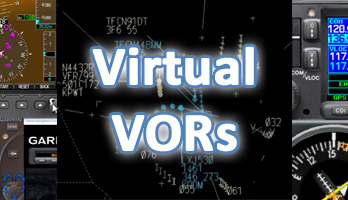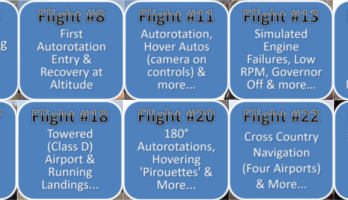This is the eleventh training flight in a series following a student through his flight training from day 1 to checkride in an R22.
Due to flying with one door off, the airflow creates some extra noise, which means some interference in the audio in some parts of the video.
In this lesson we work on hover autos (or simulated power failure at hover), which is a maneuver many students find difficult to master. To help, I adjust the camera down to get more focus on the collective as I demonstrate the maneuver. We also perform the maneuver with some forward hovering movement, which can help with progress (less concentration than holding a stationary hover) and is also an important skill (generally we spend time hovering forward more than any other hovering maneuver).
We also attempt to work more on autorotation entry at altitude, and talk about making small collective corrections and expect a slight delay in rotor RPM response. Thermal activity messes with the rotor RPM control and make it hard for a student while still learning the basics of autorotation RPM control. So we discuss how to recognize when conditions are not conducive to training on a particular maneuver (in this case big thermals and initial auto training) and consider schedulling flights earlier in the day (before thermals build).
We also work on some hover work, including practicing being able to turn your head in both directions while holding a stable hover (to enable good clearing for pedal turns). Also we do more air taxi and quick stop (rapid deceleration) maneuvers, traffic pattern work, wind recognition and effects.
Below the video are time-stamped notes/tips for the flight.
NOTES/TIPS:
00:10 The allowable to range for the RPM top end is 104% +/- 1.5% according to Robinson R22 Maintenance Manual 2.210 Inspection – run up
00:55 In a safe stabilized hover, check how much power being applied – could indicate a problem
02:00 Don’t let the wind or helicopter dictate things – you are in charge of the helicopter not the other way round
02:45 Check windsock before committing to runway
03:30 Local winds (thermals) creating conflicting windsock directions
05:15 Try to have at least 300′ AGL before turning away from the wind to give you some chance in the event of engine failure
07:20 Aim for 60kts and 300′ AGL when turning final
08:50 Most visual glide slope indicators are set for about 3 degrees
09:50 30 kts checks before committing to landing
10:30 Radio calls for clearing a runway
11:20 Practice being able to turn your head in both directions while holding a stable hover (to enable good clearing for pedal turns)
17:30 Maintain situational awareness (SA) and anticipate possible conflicts/issues and plan options ahead of time
19:00 Speak up if you think there might be a possible traffic conflict
20:30 “Number two”
23:35 Demo of Air taxi and quick stop (rapid deceleration)
24:20 Beware tailwind with quickstop – can get you in settling with power (vortex ring state)
27:50 Mention the taxiway intersection if not taking off from the end of a runway
30:10 Move head to help scan for traffic
30:45 Class D airspace dimensions
33:00 Autorotation entry at altitude
35:00 Don’t forget to roll off
36:05 Thermals messing with RPM control in auto – consider flights earlier in the day (before thermals build)
37:45 Make small corrections and expect a time delay
39:00 Recognize when conditions are not conducive to training on a particular maneuver (big thermals and inital auto training)
41:05 Get latest weather/airport information (AWOS/ATIS) when approaching an airport
49:40 Hover autos
51:15 Demo Hover auto – focus on collective – camera down
54:30 Hover auto with forward movement
To view all the videos in this series, check out this YouTube playlist of all the Flight Training Sessions (Full-Length Unedited)





